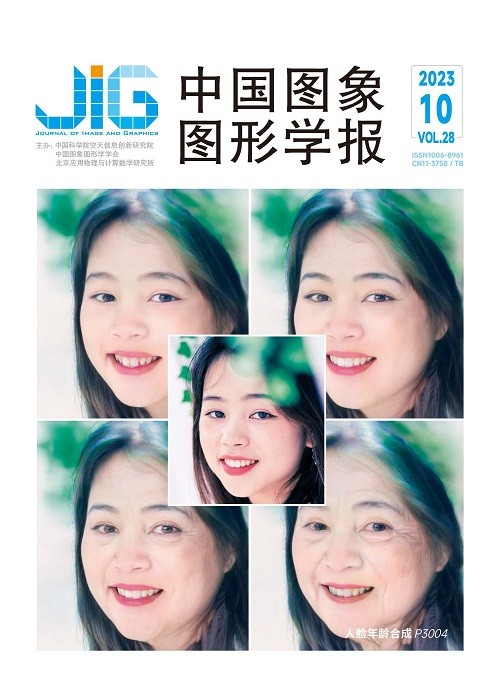
人脸年龄合成的生成对抗网络方法综述
摘 要
年龄信息作为人类生物特征识别的重要组成部分,在社会保障和数字娱乐等领域具有广泛的应用前景。人脸年龄合成技术由于其广泛的应用价值,受到了越来越多学者的重视,已经成为计算机视觉领域的重要研究方向之一。随着深度学习的快速发展,基于生成对抗网络的人脸年龄合成技术已成为研究热点。尽管基于生成对抗网络的人脸年龄合成方法取得了不错的成果,但生成的人脸年龄图像仍存在图像质量较差、真实感较低、年龄转换效果和多样性不足等问题。主要因为当前人脸年龄合成研究仍存在以下困难: 1)现有人脸年龄合成数据集的限制; 2)引入人脸年龄合成的先验知识不足; 3)人脸年龄图像的细粒度性被忽视; 4)高分辨率下的人脸年龄合成问题;5)目前人脸年龄合成方法的评价标准不规范。本文对目前人脸年龄合成技术进行全面综述,以人脸年龄合成方法为研究对象,阐述其研究现状。通过调研文献,对人脸年龄合成方法进行分类,重点介绍了基于生成对抗网络的人脸年龄合成方法。此外,本文还讨论了常用的人脸年龄合成数据集及评价指标,分析了各种人脸年龄合成方法的基本思想、特点及其局限性,对比了部分代表方法的性能,指出了该领域目前存在的挑战并提供了一些具有潜力的研究方向,为研究者们解决存在的问题提供便利。
关键词
Overview of human-facial-related age syntheis based generative adversarial network methods
Wang Yibo1, Zhang Ke1,2, Kong Yinghui1,2, Yu Tingting1, Zhao Shiwei1(1.Department of Electronic and Communication Engineering, North China Electric Power University, Baoding 071003, China;2.Hebei Key Laboratory of Power Internet of Things Technology, North China Electric Power University, Baoding 071003, China) Abstract
Human-biometric age information has been widely used for such domains like public security and digital entertainment. Such of human-facial-related age synthesis methods are mainly divided into traditional image processing methods and machine learning-based methods. Traditional image processing methods are divided into physics-based methods and prototype-based methods. Machine learning based method is focused on the model-based method,which can be divided into parametric linear model method,deep generative model method based on the time frame and generative adversarial network(GAN)-based method. The physics-based methods are focused on intuitive facial features only,for which some subtle changes are inevitably ignored,resulting in the irrationality of synthetic images. In addition,it requires a large number of facial samples for the same person at several of ages,which is costly and labor-intensive to be collected. The aging patterns generated by the prototype-based method are obtained by faces-related averaging value,and some important personalized features may be averaged,resulting in the loss of personal identity. Severe ghosting artifacts will be appeared in their synthetic images while some dictionary-based learning methods are used to preserve personalized features to some extent. Its related parametric linear model method and the deep generative model method based on the time frame are still challenged to find a general model suitable for a specific age group,and its following model established is still linear,so the quality of its synthetic image is deficient as well. The emerging GAN-based method can be used to train models using deep convolution network. Aging patterns-related age groups is learnt in terms of the generative adversarial learning mechanism,different types of loss functions are introduced for various problems appearing in the image,and the minimum value of the perceptual loss of the original image is sorted out. Aging mode can be realized in the input face image,and identity information can be preserved simultaneously. Recent GAN framework is derived of a series of variant models and has been optimizing consistently. GAN-based age synthesis methods can be segmented into four sorts of categories:GAN-classical,GANsequential,GAN-translational and GAN-conditional. For classical GAN method,it can be used to simulate face aging. However,the input information is not fully considered,which affects the identity retention,and all age maps and networks are limited under the control of age conditions,and the age accuracy of the generated image need to be optimized further. For sequential GAN method,it focuses on the sequential relationship of datasets,and there is a severe dependency. If the output of a certain model goes wrong,the performance of the whole model will be affected. Additionally,it requires consistent and completed images for each age group. The potentials of translational GAN is that a large number of photos of the same person are not required at different ages,and it needs sufficient images for each age group in the datasets only. Conditional GAN requires clear and correct labels for datasets. Compared to the methods based on translational GAN and sequential GAN,conditional GAN is extremely linked to the given limited tags in the datasets,and it is difficult to get refined control further. GAN-based methods can be used to improve the quality of generated images,but there are still some challenging problems to be resolved. Although various of face age synthesis methods based on generative adversarial network has achieved considerable progress,the generated face age image still has some problems,such as poor image quality,low realism,insufficient age transition effect and diversity. At present,the research of face age synthesis is still facing the following problems and challenges:1) the limitations of existing face age synthesis datasets;2) lack of prior knowledge of face age synthesis;3) the ignored fine granularity of face age image;4) face-related age synthesis at high resolution;and 5) current non-standardized evaluation of face age synthesis methods. Our literature review of the current face age synthesis technology is proposed,and current research situation is reviewed based on current facial age synthesis method as well. The methods of facial age synthesis can be classified,and generative adversarial network based method can be focused on as well. The commonly-used face age synthesis datasets and evaluation indicators are discussed,and the basic ideas,characteristics,and limitations of various face age synthesis methods are analyzed further. We also compare the performance of several representative methods on popular age synthesis datasets. We also predict some potential research directions and its in-depth development of related technologies.
Keywords
face age synthesis image generation face image database face aging deep generative approach generative adversarial network(GAN)
|



 中国图象图形学报 │ 京ICP备05080539号-4 │ 本系统由
中国图象图形学报 │ 京ICP备05080539号-4 │ 本系统由